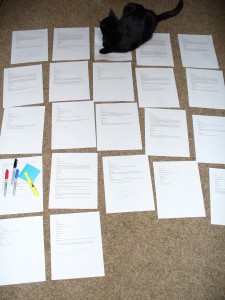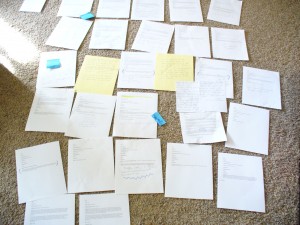For the grand opening of this blog, I’m spotlighting some of my favorite blog posts and moments from over the years throughout the month of June.
Week One: Writing Tips and Advice
.
REWORKING AN OUTLINE
First posted on March 30, 2011
Read the original post here: http://marissameyer.livejournal.com/235816.html
I hit a bit of a snag with my first draft of Winter this past weekend, when I realized that a pretty big element of the story just wasn’t going to work. (Watch me try to write this entire blog post without giving away any spoilers…)
My initial thought was to plow ahead with my outline as I’d written it and plan on fixing the problem in revisions. This is my usual solution and I think it’s generally good advice. First drafts are all about getting the messy big-picture stuff down on paper anyway, and (as Tamara Felsinger so gently reminded us in this excellent blog post a few days ago) everything can be fixed in revisions.
However, as I started writing the next chapter in the draft… one sentence… two sentences… a full paragraph… the thought kept plaguing me that this was wrong. This wouldn’t work. This wasn’t just going to require revisions, this was going to require a total rewrite.
I’m actually not opposed to the total rewrite, as daunting as it can be. Both Cinder and Scarlet have undergone it and I have a sneaky suspicion that Cress will too. But in general, I’d love to not have to completely overhaul this fourth and final book in the series if I don’t have to.
So after much thinking and pondering and struggling against the desire to Just! Keep! Writing! I finally gave in and decided it was time to pause and rework the outline before I dug my hole any deeper.
This is what it looks like when I rework an outline.
STEP ONE: Lay it all out in (current) order and figure out where the problem begins.
STEP TWO: Seek assistance. Cats are always willing to help.
Yes, this is my insanely, absurdly, horrifically long and detailed outline for Winter. Actually, this is only about a third of the book. Hence why I didn’t want to bother reworking it.
STEP THREE: Pull out any scenes related to the issue that no longer work. Reorganize remaining scenes in a logical manner.
STEP FOUR: Go over pulled scenes and try to pinpoint what needs to change in order to fix the problem. New characters and POV? New settings? New motivations? More complications?
STEP FIVE: On new paper, write short synopses for the new scenes that need to be added for everything to flow nice and smooth.
STEP SIX: Seek more help.
STEP SEVEN: Re-insert reworked scenes into outline in a way that makes sense, trying to keep a nice steady progression of action and reaction scenes and a continuous build-up to the climax.
STEP EIGHT: Read through the entire outline, highlighter and sharpie in hand, indicating any additional changes that will have to happen so that it all makes sense.
STEP NINE: Eat some chocolate. Admire your work.
STEP TEN: Stop procrastinating and get back to work, you slacker!


